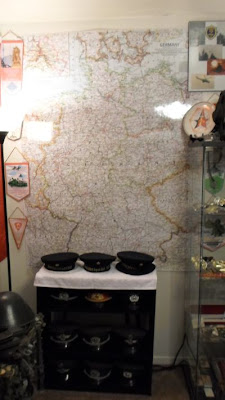1st Luftverteidigungsdivision (1st LVD) – Cottibus, East Germany
The 1st LVD was responsible for operations in southern parts of East Germany. With the Air Force and the Air Defense Units consolidated it maintained a vast number of airfields and gun batteries reflective of Soviet Air Defense doctrine. The following list of units is the major subordinate units assigned under the 1st LVD. Each unit was then broken down further into smaller units.
Jagdfliegergeschwader 1 (JG-1) „Fritz Schmenkel“ - Holzdorf
Jagdfliegergeschwader 3 (JG-3) „Wladimir Komarow“ - Preschen
Jagdfliegergeschwader 7 (JG-7) „Wilhelm Pieck“ - Drewitz
Jagdfliegergeschwader 8 (JG-8) „Hermann Matern“ - Marxwalde
41. Fla-Raketenbrigade (41. FRBr) „Hermann Dunker“ - Ladeburg
51. Fla-Raketenbrigade (51. FRBr) „Werner Lamberz“ - Sprötau
Fla-Raketenregiment 31 (FRR-31) „Jaroslaw Dombrowski“ - Straßgräbchen
Funktechnisches Bataillon 31 (FuTB 31) - Döbern
Funktechnisches Bataillon 41 (FuTB-41) „Arvid Harnack“ - Holzdorf
Funktechnisches Bataillon 51 (FuTB-51) „Paul Schäfer“ - Sprötau
Funktechnisches Bataillon 61 (FuTB-61) - Müncheberg
Nachrichtenbataillon 31 (NB-31) „August Willich“ - Cottibus
3rd Luftverteidigungsdivision (3rd LVD) - Trollenhagen, East Germany
The 3rd LVD was responsible for operations in the northern part of East Germany.
Musikkorps der LSK/LV - Trollenhagen
Jagdfliegergeschwader 2 (JG-2) „Juri Gagarin“ - Trollenhagen
Jagdfliegergeschwader 9 (JG-9) „Heinrich Rau“ - Peenemünde
Fliegertechnisches Bataillon 9 (FTB-9) „Käthe Niederkirchner“ - Peenemünde
43. Fla-Raketenbrigade (43. FRBr) „Erich Weinert“ - Sanitz
Fla-Raketenregiment 13 (FRR-13) „Etkar André“ - Parchim
Fla-Raketenregiment 23 (FRR-23) „Rudolf Breitscheid“ - Stallberg
Funktechnisches Bataillon 23 (FuTB-23) „Liselotte Herrmann“ - Pragsdorf
Funktechnisches Bataillon 33 (FuTB-33) „Fritz Behn“ - Pudagla
Funktechnisches Bataillon 43 (FuTB-43) - Parchim
Nachrichtenbataillon 33 (NB-33) „Max Christiansen-Clausen“ - Trollenhagen
The East German Air Force was essentially an extension of the Soviet Air Force’s 16th Air Army and was to be the frontline strike force for offensive operations into the West. With such a critical mission at its heart, this also resulted in less autonomy from the Soviet Union as opposed to the operating leniency granted to other Warsaw Pact nations.
The Luftstreitkräfte operated many of the USSR’s most advanced fighter designs but it’s offensive capacities were relegated to air defense and army support roles. It had no strategic bombers and had no long range capacity. Its weaponry was employed in mostly a purely defensive nature to counteract penetration by Western Air Forces.
In the event that the Cold War would have gone hot, the offensive capacity of the East German Luftstreitkräfte would be transferred under the control of an organization known as the Führungsorgan der Front- und Militärtransportfliegerkräfte which translates into the Command of the Frontal & Military Air Units. Under this unit all fighters, fighter-bombers, reconnaissance, transport and military helicopters would be realigned for offensive operations. This would not only include Luftstreitkräfte units but also Naval Aviation units as well. In the event of war, the structure of the FO FMTFK would look like this:
Jagdbombenfliegergeschwader 37 (JBG-37) „Klement Gottwald“ - Drewitz
Jagdbombenfliegergeschwader 77 (JBG-77) „Gebhardt Leberecht von Blücher“ - Laage
Marinefliegergeschwader 28 (MFG-28) „Paul Wieczorek“ - Laage
Transporthubschraubergeschwader 34 (THG-34) „Werner Seelenbinder“ - Brandenburg-Briest
Verbindungsfliegerstaffel 14 (VS-14) - Strausberg
Transportfliegerstaffel 24 (TFS-24) - Dresden-Klotzsche
Taktische Aufklärungsfliegerstaffel 47 (tAFS-47) - Preschen
Taktische Aufklärungsfliegerstaffel 87 (tAFS-87) - Drewitz















